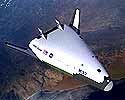| . |  |
. |
Baikonur - May 21, 1999 - An ILS Proton successfully launched Nimiq-1, a direct TV satellite for Telesat Canada, today from Baikonur Cosmodrome in Kazakstan. Lifting off on time at 4.30am local (6.30pm EDT May 20). Built by Lockheed Martin Commercial Space Systems, the satellite from 91 degrees West will provide 100s of direct TV satellite channels to Canadians from coast to coast. "The launch of Telesat's Nimiq satellite marks a major milestone in the history of Canadian broadcasting," said Larry Boisvert, Telesat's president a nd CEO. "Nimiq will ensure that our nation enters the 21st century with a satellite broadcasting system that's second to none." Nimiq is Telesat's twelfth satellite, and the first to be launched since the Anik Es in 1991. The new satellite, manufactured by Lockheed Martin Telecommunications, was launched on a Proton rocket from the Baikonur Cosmodrome at 4:30 am local time in Kazakhstan. Nimiq is based on the Lockheed Martin geosynchronous A2100 satellite bus, among the most powerful in the industry. The satellite was manufactured at the Lockheed Martin Commercial Satellite Center in Sunnyvale, CA. This satellite design is optimized for a minimum service life of 12 years, but will carry enough fuel to enable operations for several more years. It features 32 Ku-band transponders that will carry programming signals through even the worst atmospheric conditions of bad weather, including heavy snow, rain and fog. The payload for Nimiq was built at the Lockheed Martin Communications and Power Center (CPC), the state-of-the-art satellite component production facility of Commercial Space Systems located in Newtown, PA. The CPC builds payloads for Lockheed Martin satellites, as well as satellite control and telemetry components. In addition, the CPC has expertise in creating hybrid payloads that can serve a variety of applications, enabling customers to maximize orbital slots with disparate services. The three-stage Proton is produced by Khrunichev State Research and Production Space Center at its factory near Moscow. The fourth stage is built by RSC Energia, also near Moscow. The satellite was built by Lockheed Martin at its commercial satellite facilities in Sunnyvale, Calif., USA, and is an A2100AX design. International Launch Services (ILS) is providing mission management for the Proton launch. This will be the third ILS commercial launch to be carried out on Proton this year and the eleventh commercial launch since the Lockheed Martin, Khrunichev and Energia joint venture was formed. Proton is also the primary heavy lifter for Russian government payloads and selected commercial launches secured by Khrunichev before the formation of ILS. International Launch Services (ILS) provided mission management for the launch, using a team of Russian and American specialists. The launch proceeded smoothly, and Telesat received word of the successful separation of the spacecraft approximately six hours later. Deployment of antennas and solar arrays will occur approximately eight days after launch as the spacecraft approaches its final orbital position. Nimiq will then undergo in-orbit testing and, by mid-June, Telesat will be in a position to confirm the beginning of commercial service. The primary customer on Telesat's Nimiq satellite will be Bell ExpressVu, which will use the satellite to enhance its direct-to-home television service across Canada. Nimiq will give Bell ExpressVu the ability to broadcast to an 18-inch dish and significantly expand its programming line-up.
 Washington - May 21, 1999 -
Washington - May 21, 1999 -  Washington - May 21, 1999 - Lockheed Martin told Congress Thursday the VentureStar reusable space vehicle project was unable to attract Wall Street investors and would need some form of added government funding or loan backing.
Washington - May 21, 1999 - Lockheed Martin told Congress Thursday the VentureStar reusable space vehicle project was unable to attract Wall Street investors and would need some form of added government funding or loan backing. |
|
|
|
|
|
|
|
|
|
|
|
|
|
| The content herein, unless otherwise known to be public domain, are Copyright 1995-2006 - SpaceDaily.AFP and UPI Wire Stories are copyright Agence France-Presse and United Press International. ESA PortalReports are copyright European Space Agency. All NASA sourced material is public domain. Additionalcopyrights may apply in whole or part to other bona fide parties. Advertising does not imply endorsement,agreement or approval of any opinions, statements or information provided by SpaceDaily on any Web page published or hosted by SpaceDaily. Privacy Statement |